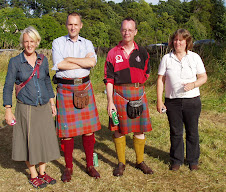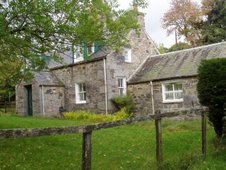Thank you for the thoughts on kale. Oddly (for Strathardle), I don’t think cold is the problem. Just deer. I was especially glad to hear from you, Beverly, remembering winters in NJ as I do – although mine didn’t involve kale-growing.
You’ll have noticed the lack of frizziness in yesterday’s pic. I grow Sutherland kale from the Real Seed Company (scroll down a bit). It has never lasted past January, and last year the deer polished it off in November. I put sawn-off plastic water bottles over the stumps, hoping it might regenerate, but it didn’t. If netting works, we could have not only kale but sprouting broccoli in the cheerful, windy weeks of March. An enticing thought.
I don’t know how cold we get – a serious omission. I’d be surprised at much less than -10 C though. I know that it’s often less than +10 C in the kitchen when we arrive – which means that the refrigerator doesn’t work (and doesn’t really need to). But that’s irrelevant to the survival of kale.
Knitting
The Amedro shawl progresses. I did some arithmetic at the beginning and decided that I would allow myself one percentage point for the sidebar for every three rows of pattern, in the main part. That’s a delicious cheat, because the rows are getting shorter as I progress. I think that should leave enough percentage points to deal with the top edging. We’ll see.
I also think – look again at that last picture yesterday – that I went wrong in the first half of the first pattern repeat of the centre section. It’s a pattern of little circles, suspended in netting, every other row of them offset. And the first row of little circles sort of isn’t there.
Shandy, Sharon Miller’s “Love Darg Shetland Shawls” book is extremely interesting. She had begun to notice near-identical designs in several Shetland shawls in her collection from widely differing dates – interesting, because knitters usually did something different every time, unless they were reproducing a presentation piece. (Like the Princess shawl in the Museum of Scotland, which is a repeat of the one presented to the Princess.)
Then she got hold of an edition of “Aunt Kate’s Home Knitter” which she collects as I do Vogue Knitting Books. It is full of lace patterns, including the one Sharon had noticed being replicated, and she thinks – with good reason, I believe – that it may be the first appearance in print of true gossamer lace Shetland shawl patterns.
Sharon’s book reproduces all the patterns from Aunt Kate, with Sharon’s own charts. The one I’m using is sort of a throw-away at the bottom of page 29, un-illustrated as I have said. But if Sharon is right about “Aunt Kate’s Home Knitter”, the answer would be yes, the pattern comes from Shetland. I’m not absolutely clear about the date of the Aunt Kate book, but it’s clearly 1910 give or take a year or two.
“Diagonal Knitting” has turned up from the Schoolhouse. I’ll have to think about it. It’s very artistic, not patterns but techniques. I doubt if there’s anything there for me.
The author is a bit of a feminist. “Women wear slacks, still a man in a dress is either clowning or a transvestite.” Or, of course, a Scotsman. In the Great War, some Scottish regiments wore the kilt in battle. The Germans called them The Ladies from Hell.
Subscribe to:
Post Comments (Atom)



I use curly leaf kale or Nero de Tuscana. The curly leaf stood up well through the cold winter last year so I'd recommend it. It's also very good at regrowing. I pick the leaves off from the bottom upwards, for soup or stir fries, and three or four plants will last me the winter.
ReplyDeleteFor netting I use square (not the stretchy kind) mesh net from the garden centre stretched over a frame made from scrap alkathene piping (the blue or yellow stuff used for water or gas piping), canes and zip ties, and pegged down with pegs cut from old wire coathangers. You can see this brassica "cage" in some of my blog photos. It's 3 feet high and 4 feet across so a 4 metre/13 wide net, on top of a foot foot wide bed, gives plenty of margin to peg down. And once pegged down the cage can take the weight of a ten year old child falling into it(!)so it might just stand up to a deer. It's also good for keeping butterflies and pigeons off the brassicas.
Picture in the background here...
ReplyDeletehttp://spinningfishwife.blogspot.com/2010/02/soup-plot.html
Scrap alkathene piping comes out of skips or from your friendly local workmen that are digging up the roads, or you can even buy a roll from a builders merchant. It cuts easily with a hacksaw and makes nice hoops over a bed. To make a square corner bend you cut it half way through and fold it there. To fix it into the ground you use 18" canes or poles of some sort, push thenm in half way then sip the pipe over the protruding piece.
This is a Geoff Hamilton recommended method btw, so has to be good!
My parents grow kale all winter long (In Southern California where it almost never freezes because they are within 20 miles of the coast). For them the problem isn't deer but that their two cats like to sleep on top of the kale. My father had devised all kinds of things, but still, cats in the kale... it drives my mom crazy, because she loves her kale.....
ReplyDeleteThe copy of Sharon's book arrived - Post Office was at fault. It makes fascinating reading - even for a non-knitter like my father. Most knitters I know would not contemplate even working on simple lace and there was "Aunt Kate" providing such complex patterns for all.
ReplyDeleteI do like Sharon's charts too. They are so clear.
Other non-clown males the author left out: medieval recreationists, men in traditional dress of most of the Eastern hemisphere and lately adopted by much of Africa, many priests, workmen wearing long dusters, any man in a dressing gown or bathrobe, and at a quick glance, any man in 18th century costume as well (long coat covering knee-pants).
ReplyDeleteThe Scottish regiments must have left an impression on the Germans if they were "from hell".
ReplyDeleteI believe part of what made them "from Hell" was use of the bagpipes - the military outdoor sort.
ReplyDelete